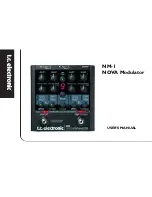
FRAM71B
User’s Manual
FRAM71B 1.00
- 14 -
©Hans Brueggemann, 2016
The Chip-configuration nibbles (high nibbles in the configuration bytes at H_0x2C000,
H_0x2C002,…) may have the following values:
Size of Chip [KByte]
Config Nibble
Value
Last Chip in
Module (LCIM)
Device
Type
FRAM
USED
Size
Bit_1
Size
Bit_0
0 (deactivated)
0
0
--
--
--
--
32
1)
3
OFF
RAM
TOP
1
1
7
OFF
ROM
TOP
1
1
B
ON
RAM
TOP
1
1
F
ON
ROM
TOP
1
1
16
2
OFF
RAM
BOT
1
0
6
OFF
ROM
BOT
1
0
A
ON
RAM
BOT
1
0
E
ON
ROM
BOT
1
0
32
1
OFF
RAM
BOT
0
1
5
OFF
ROM
BOT
0
1
9
ON
RAM
BOT
0
1
D
ON
ROM
BOT
0
1
Table 3: Allowed Chip-Sizes and -Types.
1)
FRAM71B-1024 only.
Notes
1. A Chip that is configured to less than 32 KBytes always occupies its entire F_Block, as
shown in Table 1. However, it occupies only as much of your HP-71B's address space
as it is configured to.
2. Chip-addresses as "seen" by your HP-71B will vary according to the calculator’s
memory configuration routine. For example, if you configure RAM with Chip_0 =
16 KByte and Chip_1 = 32 KByte, they may have their FRAM base addresses at
F_0x30000 and F_x40000, respectively. However, your HP-71B will configure Chip_0
at H_0x40000 and Chip_1 at H_0x30000.
3. [PEEK$] and [POKE] always work on H-addresses.
4. Chips that are declared as ROM, as well as unused F_Blocks, will not be affected by
"MEMORY LOST" or a power loss condition.
5. Chip_0 is a special-purpose Chip that can be changed to hard-configured (HC-) ROM
by setting a jumper on FRAM71B's component board. When enabled to act as HC-
ROM, Chip_0 appears to your HP-71B as ROM at the fixed address H_0xE0000. Its
contents are not affected by "MEMORY LOST" or a power loss condition.
6. If you plan to use Chips as soft-configured ROMs to hold images of application ROMs,
it is suggested (but not required) to configure them the same way as they are in the
original applications module. Otherwise, the Diagnostic ROM may falsely report
those Chips as "BAD”.















































